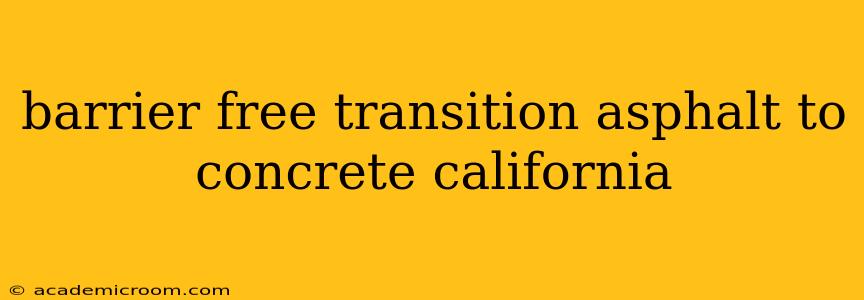California, known for its commitment to accessibility, demands careful consideration when transitioning between asphalt and concrete surfaces. A smooth, barrier-free transition is crucial for wheelchair users, individuals with mobility aids, and others who may experience difficulties navigating uneven surfaces. This article explores the best practices and requirements for creating accessible transitions between asphalt and concrete pavements in the Golden State.
What are the California accessibility guidelines for asphalt to concrete transitions?
California's accessibility standards largely align with the Americans with Disabilities Act (ADA) and the California Building Code (CBC). These regulations specify that transitions between different paving materials must be smooth and free of abrupt changes in level. The maximum allowable slope for a transition is typically 1:20 (a 5% grade), and any change in level exceeding 1/4 inch requires a ramp or other compliant transition method. Specific details can be found within the relevant sections of the ADA Standards for Accessible Design and the CBC. Consult these codes and local building department guidelines for the most current and precise information.
How steep can a transition from asphalt to concrete be in California?
As mentioned above, the maximum allowable slope for a transition between asphalt and concrete in California generally adheres to the 1:20 (5% grade) rule. Exceeding this slope necessitates the implementation of a ramp to ensure accessibility. It's vital to note that local jurisdictions may have more stringent requirements, so always check with your local building department before beginning any construction or paving project.
What materials are best for barrier-free asphalt to concrete transitions in California?
Several materials provide smooth and durable barrier-free transitions. These include:
- Concrete ramps: These are commonly used for larger transitions and offer excellent durability.
- Asphalt ramps: Suitable for smaller transitions, these can be blended seamlessly with existing asphalt paving.
- Specialized transition products: Several manufacturers offer pre-fabricated transition products designed to create a smooth and compliant transition. These often incorporate rubber or other flexible materials to absorb shock and reduce tripping hazards.
What are the costs associated with creating a barrier-free asphalt to concrete transition?
The cost of creating a barrier-free transition varies greatly depending on several factors, including:
- Size of the transition: Larger transitions requiring ramps will naturally be more expensive.
- Materials used: The choice of materials significantly impacts the overall cost.
- Labor costs: The cost of labor varies depending on location and the complexity of the project.
- Permitting fees: Obtaining the necessary permits adds to the overall cost.
Obtaining quotes from multiple contractors will provide a more accurate estimate specific to your project.
How can I ensure my asphalt to concrete transition meets California accessibility standards?
To ensure compliance with California's accessibility standards:
- Consult with a qualified professional: Consult with a civil engineer or contractor experienced in ADA and CBC compliance.
- Review relevant codes and regulations: Thoroughly review the ADA Standards for Accessible Design and the CBC to understand the specific requirements.
- Obtain necessary permits: Secure all necessary permits before starting construction.
- Document compliance: Maintain accurate records of the project and its compliance with accessibility standards.
By following these guidelines and working with qualified professionals, you can ensure your asphalt to concrete transitions meet California’s accessibility requirements and create a safer, more inclusive environment for everyone. Remember to always consult your local building department for the most up-to-date and specific regulations in your area.
